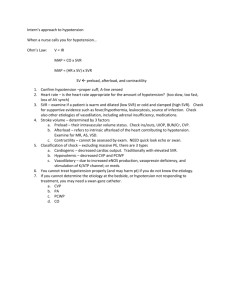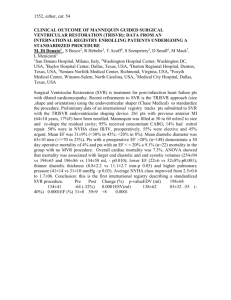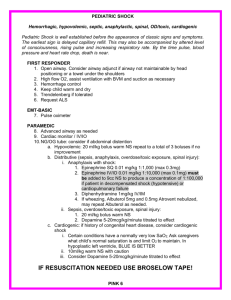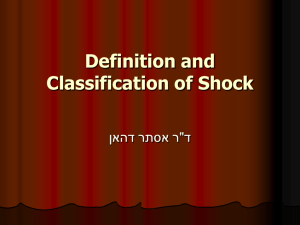Shock: Types, Pathophysiology, and Clinical Features
advertisement
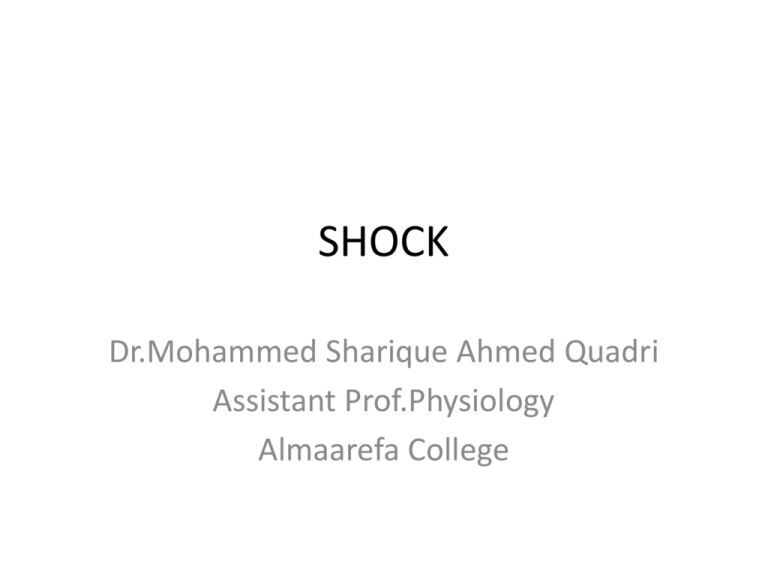
SHOCK Dr.Mohammed Sharique Ahmed Quadri Assistant Prof.Physiology Almaarefa College WHAT IS SHOCK? • Shock is the term used to describe acute circulatory failure with inadequate or inappropriately distributed tissue perfusion resulting in generalized cellular hypoxia and/or an inability of the cells to utilize oxygen. SHOCK IS A SYNDROME THAT CAN OCCUR IN THE COURSE OF MANY LIFE THREATENING TRAUMATIC CONDITIONS OR 2 DISEASE STATES Or it can be define simply as A clinical state in which tissues do not receive adequate blood flow and O2 to meet their metabolic needs. 3 Physiological Principles Tissue perfusion is driven by mean arterial pressure MAP MAP = CO X PVR CO – Cardiac Output PVR – Peripheral Vascular resistance 4 Cardiac Output CO = SV X HR This means that MAP= SV X HR X PVR Blood Pressure = Stroke Volume X Heart Rate X Peripheral Vascular Resistance • • MAP= DP+ 1/3 PP and normal value for adult is between 60 and 110 mm Hg Normal adult CO is about 5 L/ min& is equal for both ventricles 5 Stroke Volume • Volume of Blood pumped by the heart during 1 cycle What affects Stroke volume? Blood Volume Mechanical Obstruction Rhythm Problems Heart Muscle Damage Stroke Volume Mechanical Obstruction 6 What makes up blood volume Plasma RBCs Platelets WBCs 7 What Alters Blood Volume? • Haemorrhage • Plasma Loss • Loss /Redistribution of Extracellular Volume 8 Heart Rate • Heart rate increases as a compensatory response to Shock Heart rate too fast to allow adequate refilling of heart between beats 9 Peripheral Vascular Resistance PVR regulated by ARTERIOLAR tone. Dilatation opens Arteriovenous beds & increases volume of circulatory system 10 What Alters PVR? • Circulating cytokines & Inflammatory mediators (e.g. Histamine) • Endotoxins • Drugs (e.g. Nitrates) 11 So tissue and cellular perfusion is dependent on • Adequate preload • Functioning heart • Intact blood vessels 12 TYPES OF SHOCK HYPOVOLEMIC CARDIOGENIC OBSTRUCTIVE DISTRIBUTIVE 13 14 Pathophysiology: Overview • Tissue perfusion is determined by Mean Arterial Pressure (MAP) MAP = CO x SVR Heart rate Stroke Volume Hypovolemic Shock: Pathophysiology • Heart pumps well, but not enough blood volume to pump MAP = CO x SVR HR x Stroke volume Hypovolemic Shock: Pathophysiology Normal MAP = CO x SVR Hypovolemic MAP = ↓CO x SVR MAP = ↓CO x ↑ SVR ↓MAP = ↓↓CO x ↑ SVR Hypovolemic Shock: Causes ↓MAP = ↓ CO (HR x Stroke Volume) x ↑SVR • Decreased Intravascular volume (Preload) leads to Decreased Stroke Volume – Hemorrhagic - trauma, GI bleed, AAA rupture, ectopic pregnancy – Hypovolemic - burns, GI losses, dehydration, third spacing (e.g. pancreatitis, bowel obstruction), Adesonian crisis, Diabetic Ketoacidosis Cardiogenic Shock: Pathophysiology • Heart fails to pump blood out MAP = CO x SVR HR Stroke Volume Cardiogenic Shock: Pathophysiology • Heart fails to pump blood out MAP = CO x SVR HR Stroke Volume Cardiogenic Shock: Pathophysiology Normal MAP = CO x SVR Cardiogenic MAP = ↓CO x SVR MAP = ↓CO x ↑ SVR ↓MAP = ↓↓CO x ↑ SVR Cardiogenic Shock: Causes ↓MAP = ↓ CO (HR x Stroke Volume) x ↑SVR • Decreased Contractility (Myocardial Infarction, myocarditis, cardiomypothy, Post resuscitation syndrome following cardiac arrest) • Mechanical Dysfunction – (Papillary muscle rupture post-MI, Severe Aortic Stenosis, rupture of ventricular aneurysms etc) • Arrhythmia – (Heart block, ventricular tachycardia, SVT, atrial fibrillation etc.) • Cardiotoxicity (B blocker and Calcium Channel Blocker Overdose) Obstructive Shock: Pathophysiology • Heart pumps well, but the output is decreased due to an obstruction (in or out of the heart) MAP = CO x SVR HR x Stroke volume Obstructive Shock: Pathophysiology Normal MAP = CO x SVR Obstructive MAP = ↓CO x SVR MAP = ↓CO x ↑ SVR ↓MAP = ↓↓CO x ↑ SVR Obstructive Shock: Causes ↓MAP = ↓ CO (HR x Stroke Volume) x ↑SVR • Heart is working but there is a block to the outflow – – – – Massive pulmonary embolism Aortic dissection Cardiac tamponade Tension pneumothorax • Obstruction of venous return to heart – Vena cava syndrome - eg. neoplasms, granulomatous disease – Sickle cell splenic sequestration Distributive Shock: Pathophysiology • Heart pumps well, but there is peripheral vasodilation due to loss of vessel tone MAP = CO x SVR HR x Stroke volume Distributive Shock: Pathophysiology Normal MAP = CO x SVR Distributive MAP = co x ↓ SVR MAP = ↑co x ↓ SVR ↓MAP = ↑co x ↓↓ SVR Distributive Shock: Causes ↓MAP = ↑CO (HR x SV) x ↓ SVR • Loss of Vessel tone – Inflammatory cascade • Sepsis and Toxic Shock Syndrome • Anaphylaxis • Post resuscitation syndrome following cardiac arrest – Decreased sympathetic nervous system function • Neurogenic - C spine or upper thoracic cord injuries – Toxins • Due to cellular poisons -Carbon monoxide, methemoglobinemia, cyanide • Drug overdose (a1 antagonists) PATHOPHYSIOLOGY OF SHOCK So the pathophysiology of shock can be explained as cellular hypoxia resulting from impaired tissue perfusion • The manifestation of shock reflects both – The impaired perfusion of body tissue & – The body’s attempt to maintain tissue perfusion (compensatory mechanism) 29 COMPENSATORY MECHANISMS 30 Compensatory mechanism and shock AFTER-LOAD PRE-LOAD Fluid Cardiac Vascular Volume Output Diameter (CVP/JVP) (SV x HR) (SVR) 31 Hypovolaemic shock AFTER-LOAD PRE-LOAD Fluid Cardiac Vascular Volume Output Diameter (CVP/JVP) (SV x HR) (SVR) 1 32 Hypovolaemic shock AFTER-LOAD PRE-LOAD Fluid Cardiac Vascular Volume Output Diameter (CVP/JVP) (SV x HR) (SVR) 1 33 Hypovolaemic shock AFTER-LOAD PRE-LOAD Fluid Cardiac Vascular Volume Output Diameter (CVP/JVP) (SV x HR) (SVR) 1 3 34 Cardiogenic shock AFTER-LOAD PRE-LOAD Fluid Cardiac Vascular Volume Output Diameter (CVP/JVP) (SV x HR) (SVR) 1 35 Cardiogenic shock AFTER-LOAD PRE-LOAD Fluid Cardiac Vascular Volume Output Diameter (CVP/JVP) (SV x HR) (SVR) 1 2 36 Cardiogenic shock AFTER-LOAD PRE-LOAD Fluid Cardiac Vascular Volume Output Diameter (CVP/JVP) (SV x HR) (SVR) 3 1 2 37 Distributive shock AFTER-LOAD PRE-LOAD Fluid Cardiac Vascular Volume Output Diameter (CVP/JVP) (SV x HR) (SVR) 1 38 Distributive shock AFTER-LOAD PRE-LOAD Fluid Cardiac Vascular Volume Output Diameter (CVP/JVP) (SV x HR) (SVR) 2 1 39 Distributive shock AFTER-LOAD PRE-LOAD Fluid Cardiac Vascular Volume Output Diameter (CVP/JVP) (SV x HR) (SVR) 2 3 1 40 Type of Shock Insult Physio Compen Compensation logic sation Heart Rate Effect Cardiogenic Heart fails to pump blood out ↓CO BaroRc ↑SVR ↑ ↑ Obstructive Heart pumps well, but the outflow is obstructed ↓CO BaroRc ↑SVR ↑ ↑ Hemorrhagic Heart pumps ↓CO well, but not enough blood volume to pump BaroRc ↑SVR ↑ ↑ Distributive Heart pumps well, but there is peripheral vasodilation ↑CO ↑ ↑ No Change in neurogenic shock No Change in neurogenic shock ↓SVR Compensation Contractility Sympatho-Adrenal Response to Shock • Most immediate of compensatory mechanisms are those of sympathetic nervous system and renin angiotensin mechanism • Sympathetic nervous system • NE, epinephrine, and cortisol release • Causes vasoconstriction, increase in HR, and increase of cardiac contractility (cardiac output) • Renin-angiotensin axis • Water and sodium conservation and vasoconstriction • Increase in blood volume and blood pressure 42 Sympatho-Adrenal Response to Shock 43 Neuroendocrine response • Release of pituitary hormones such as adrenocorticotrophic hormone (ACTH), vasopressin(antidiuretic hormone, ADH). • There is release of cortisol, which causes fluid retention and antagonizes insulin. • There is release of glucagon, which raises the blood sugar level. 44 Release of Pro- and Anti Inflammatory Mediators • Severe infection (bacteraemia/endotoxaemia), • Presence of large areas of damaged tissue (following trauma /extensive surgery) • Prolonged episodes of hypoperfusion Trigger an exaggerated inflammatory response (systemic activation of leucocytes & release of potentially damaging ‘mediators’) 45 Release of Pro- and Anti Inflammatory Mediators (continued) • Pro inflammatory Mediators: – Proteases – Toxic free radicals & other reactive oxygen species – Cytokines • IL • TNF Are involved in leukocyte adhesion ,local inflammation, neutrophil activation, fever, lactic acidosis, ventilation perfusion abnormalities – Platelet activating factor • Hypotension, Inc. vascular permeability, platelet aggregation. • Anti inflammatory mediators: – Interleukin 10 ( IL-10) 46 Release of Pro- and Anti Inflammatory Mediators (continued) • Although beneficial when targeted against local areas of infection or necrotic tissue-dissemination of this ‘innate immune’ response can produce shock and widespread tissue damage. • Characteristically the initial episode of overwhelming inflammation is followed by a period of immune suppression--- increased risk of developing secondary infections. 47 TO BE CONTINUED TOMORROW THANK YOU 48 CLINICAL FEATURES OF SHOCK 49 50 51 52 53 THANK YOU Reference Kumar & Clark's Clinical Medicine, 7th Edition 54


